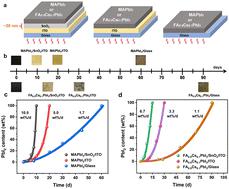当前位置:
X-MOL 学术
›
Energy Environ. Sci.
›
论文详情
Our official English website, www.x-mol.net, welcomes your feedback! (Note: you will need to create a separate account there.)
Thermal instability originating from the interface between organic–inorganic hybrid perovskites and oxide electron transport layers
Energy & Environmental Science ( IF 32.5 ) Pub Date : 2022-10-04 , DOI: 10.1039/d2ee02649j Jingsi Song 1 , Hongpeng Liu 1 , Wenhua Pu 2 , Yue Lu 1 , Zhixiang Si 1 , Zeyu Zhang 1 , Yang Ge 1 , Nengxu Li 3 , Huanping Zhou 3 , Wei Xiao 2 , Ligen Wang 2 , Manling Sui 1
Energy & Environmental Science ( IF 32.5 ) Pub Date : 2022-10-04 , DOI: 10.1039/d2ee02649j Jingsi Song 1 , Hongpeng Liu 1 , Wenhua Pu 2 , Yue Lu 1 , Zhixiang Si 1 , Zeyu Zhang 1 , Yang Ge 1 , Nengxu Li 3 , Huanping Zhou 3 , Wei Xiao 2 , Ligen Wang 2 , Manling Sui 1
Affiliation

|
The thermal instability of organic–inorganic halide perovskite solar cells (PSCs) is one of the most important factors restraining their commercialization. It has recently been reported that modifications at the interface between the electron transport layer (ETL) and the perovskite layer could effectively promote the long-term thermal stability of high-efficiency PSCs. However, few studies have disclosed the effect of the microstructure of ETLs, such as SnO2 or TiO2, on the thermal degradation pathway of the perovskite layer at nano-, or even atomic-scale, resolution. In this work, a variety of characterization techniques were used to detect the diffusion of the oxygen element from SnO2/TiO2 layers into organic–inorganic hybrid perovskite (OIHP) layers, which was accompanied by the thermal decomposition of MAPbI3 and FA0.9Cs0.1PbI3 films. Moreover, a preferential thermal decomposition of the perovskite layer at the SnO2–perovskite interface was confirmed to be an adverse factor inducing the performance degradation of PSCs. First-principles calculations further elucidate that dangling bonds at the SnO2 or TiO2 ETL–perovskite interface down-regulate the oxygen vacancy formation energy. Furthermore, a low segregation energy for oxygen diffusion (0.19–0.55 eV and 0.26 eV at SnO2 and TiO2–perovskite interfaces, respectively) accelerates the transfer of the oxygen element from SnO2 or TiO2 into OIHP layers and promotes the transfer of protons in the perovskite layer. Furthermore, the fabrication of planar OIHP solar cells based on an O2-plasma treated ETL SnO2 layer effectively improved their photoelectric performance and thermal stability, further confirming the important role of interfacial oxygen in modulating the stability of PSC devices.
中文翻译:

源自有机-无机杂化钙钛矿和氧化物电子传输层之间界面的热不稳定性
有机-无机卤化物钙钛矿太阳能电池(PSC)的热不稳定性是限制其商业化的最重要因素之一。最近有报道称,在电子传输层(ETL)和钙钛矿层之间的界面上进行修饰可以有效地促进高效 PSC 的长期热稳定性。然而,很少有研究揭示 ETL 的微观结构(如 SnO 2或 TiO 2)在纳米级甚至原子级分辨率下对钙钛矿层热降解途径的影响。在这项工作中,多种表征技术被用于检测 SnO 2 /TiO 2中氧元素的扩散层转变为有机-无机杂化钙钛矿(OIHP)层,伴随着MAPbI 3和FA 0.9 Cs 0.1 PbI 3薄膜的热分解。此外,在 SnO 2 -钙钛矿界面处钙钛矿层的优先热分解被证实是导致 PSC 性能下降的不利因素。第一性原理计算进一步阐明了 SnO 2或 TiO 2 ETL-钙钛矿界面处的悬空键会下调氧空位形成能。此外,氧扩散的低偏析能(在 SnO 2和 TiO 2处为 0.19-0.55 eV 和 0.26 eV-钙钛矿界面)加速氧元素从 SnO 2或 TiO 2转移到 OIHP 层中,并促进钙钛矿层中质子的转移。此外,基于O 2等离子体处理的ETL SnO 2层的平面OIHP太阳能电池的制造有效地提高了它们的光电性能和热稳定性,进一步证实了界面氧在调节PSC器件稳定性中的重要作用。
更新日期:2022-10-04
中文翻译:

源自有机-无机杂化钙钛矿和氧化物电子传输层之间界面的热不稳定性
有机-无机卤化物钙钛矿太阳能电池(PSC)的热不稳定性是限制其商业化的最重要因素之一。最近有报道称,在电子传输层(ETL)和钙钛矿层之间的界面上进行修饰可以有效地促进高效 PSC 的长期热稳定性。然而,很少有研究揭示 ETL 的微观结构(如 SnO 2或 TiO 2)在纳米级甚至原子级分辨率下对钙钛矿层热降解途径的影响。在这项工作中,多种表征技术被用于检测 SnO 2 /TiO 2中氧元素的扩散层转变为有机-无机杂化钙钛矿(OIHP)层,伴随着MAPbI 3和FA 0.9 Cs 0.1 PbI 3薄膜的热分解。此外,在 SnO 2 -钙钛矿界面处钙钛矿层的优先热分解被证实是导致 PSC 性能下降的不利因素。第一性原理计算进一步阐明了 SnO 2或 TiO 2 ETL-钙钛矿界面处的悬空键会下调氧空位形成能。此外,氧扩散的低偏析能(在 SnO 2和 TiO 2处为 0.19-0.55 eV 和 0.26 eV-钙钛矿界面)加速氧元素从 SnO 2或 TiO 2转移到 OIHP 层中,并促进钙钛矿层中质子的转移。此外,基于O 2等离子体处理的ETL SnO 2层的平面OIHP太阳能电池的制造有效地提高了它们的光电性能和热稳定性,进一步证实了界面氧在调节PSC器件稳定性中的重要作用。


























 京公网安备 11010802027423号
京公网安备 11010802027423号